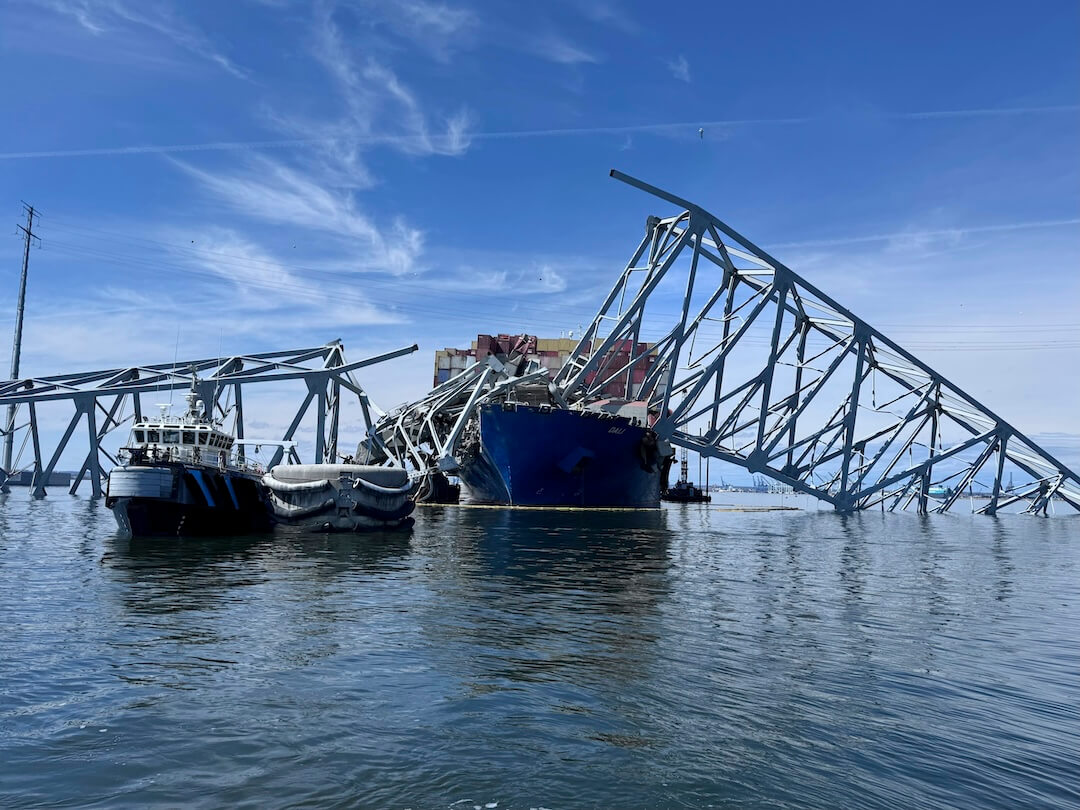After President Joe Biden said the federal government would pay to replace Baltimore’s Francis Scott Key Bridge, a project estimated to cost from $400 million to over $1 billion, some social media users questioned why the company that owned the ship isn’t footing the bill.
Biden, in March 26 remarks after the accident, said the federal government “will pay for the entire cost of reconstructing that bridge,” and he expected congressional support for that effort.
On social media, users expressed outrage.
“That ship was commissioned by a Danish company. It was operating under a Singapore flag … President Biden thinks the American taxpayers should foot the bill to clean up the mess and rebuild the bridge. I think there’s a foreign company that owes us a bridge!” read three Facebook posts that shared the same graphic.
“Why are WE responsible for paying for this!! Make it make sense!!” another Facebook post said.
Former House Speaker Newt Gingrich, R-Ga., criticized Biden, writing in an X post, “Why add a billion dollars to US debt when the big insurance companies exist for precisely this purpose?”
The ship that struck the bridge was owned by Singapore-based company Grace Ocean Private Ltd. It was managed by Singapore-based ship management company Synergy Marine Group, and chartered by Danish shipping company Maersk.
Grace Ocean Private Ltd. and Synergy Marine Group filed a court petition April 1 seeking to cap their liability at about $43.6 million.
The federal Department of Transportation on March 28 announced $60 million in “quick release” Emergency Relief funds for the Maryland Department of Transportation Department to begin rebuilding the bridge, describing it as an “initial down payment of funds.”
Getting the bridge repaired and the Port of Baltimore open to ship traffic is an economic imperative for Maryland and for the U.S., Maryland and federal officials said.
The bridge carried more than 30,000 vehicles a day, state officials said. The Port of Baltimore in 2021 was the 17th largest in the U.S. in terms of annual total tonnage of cargo, U.S. Department of Transportation data shows.
Maryland’s Democratic governor, Wes Moore, said March 31 on “Fox News Sunday” that the bridge collapse isn’t affecting Maryland’s economy alone, but also states across the country.
The support Baltimore has received “isn’t because anyone is trying to do Maryland a favor,” Moore said. “It’s because the national economy relies on the Port of Baltimore being up and running,”
Where will the money come from and will feds foot the entire bill?
The federal government stepping in to pay to rebuild the bridge doesn’t necessarily mean taxpayers will cover the entire bill.
When reporters asked Biden March 26 whether the company that owned the ship should be held responsible, Biden said, “That could be, but we’re not going to wait if that happened. We’re going to pay for it to get the bridge rebuilt and open.”
Transportation Secretary Pete Buttigieg said at a March 27 news briefing that “any private party that is found responsible and liable will be held accountable” for the bridge accident.
Analysts say insured losses including for bridge repair and business interruption could amount to up to $4 billion. But lawsuits in similar disasters have taken years to settle.
Peter Knudson, a National Transportation Safety Board spokesperson, said its investigation is expected to last one to two years.
Sen. Chris Van Hollen, D-Md., said on ABC’s “This Week with George Stephanopoulos” that “The federal government will pay 90% of the costs,” and he plans to introduce legislation to cover the other 10%.
Treasury Secretary Janet Yellen in a March 27 MSNBC interview, said money from the 2021 Bipartisan Infrastructure Law could help pay some of the costs, but said she expected insurance to cover those costs partly.
Buttigieg said March 31 on CBS’ “Face the Nation” that more than the initial $60 million in emergency released funding will come, but “it is possible we may need to turn to Congress to supplement that fund. That has happened in the past.”
Although some Republicans in Congress have expressed opposition to paying for the repairs, Senate Minority Leader Mitch McConnell, R-Ky., said in an April 1 radio interview that the federal government will pay “the lion’s share” of the cost to replace the bridge.
Buttigieg pointed to bipartisan support for a $250 million reconstruction package following 2007 collapse of the Interstate N35 in Minnesota.
The bridge’s August 2007 collapse near downtown Minneapolis took down 111 vehicles, killing 13 people and injuring 145. The NTSB concluded that the probable cause was “inadequate load capacity, due to a design error” of some of the bridge’s structures.
With the state estimated to lose about $60 million in economic output in 2007 and 2008 because of the bridge’s absence, Congress three days after the bridge’s collapse authorized the reconstruction funding. Two days after that, former President George W. Bush signed it into law. The bridge was completed in 13 months.
URS Corp., the engineering company tasked to evaluate the bridge before it collapsed, agreed to pay $52.4 million to the tragedy’s victims.
Federal government has paid up front for similar disasters
Steve Ellis, president of the Taxpayers for Common Sense, an independent group that analyzes federal spending, said the federal government often intervenes after disasters to pay for the immediate response.
“In this case, where there are other insured actors, like the shipping line, the federal government should go after them for reimbursement and penalties,” Ellis said.
Andy Winkler, director of the Bipartisan Policy Center’s infrastructure project, said the Biden administration’s quick offer of assistance in the Baltimore bridge collapse does not preclude the federal government from recouping costs should a private sector party be found responsible.”
Here are some examples of the federal government paying up front and seeking reimbursement later:
Deepwater Horizon and Exxon Valdez oil spills: Ellis and Winkler each pointed to the 2010 Deepwater Horizon oil spill in the Gulf of Mexico, and Ellis also noted the 1989 Exxon Valdez oil spill in Alaska as examples of the federal government contributing to upfront costs and recovering moneymore through settlements with the companies responsible. Those settlements took six years to reach in the Deepwater spill and two in the Exxon spill.
The Deepwater spill, triggered by an oil rig explosion that killed 11 people, was the largest U.S. marine oil spill ever, releasing about 130 million gallons of oil into the sea and soiling five states coastlines. The federal government reached a $20.8 billion settlement with BP, the largest environmental settlement in U.S. history, that was approved in 2016 by a federal judge.
“The federal government provided assistance, including funding to support cleanup efforts, all while aggressively pursuing compensation for all damage,” Winkler said.
Before Deepwater Horizon, the 1989 Exxon Valdez oil spill had been the worst in U.S. history. An Exxon oil tanker struck a reef in Prince William Sound, Alaska, spilling 11 million gallons of crude oil into the water. Exxon agreed to pay $1 billion in fines and damages, the Enviromental Protection Agency said in 1991. Overall, Exxon said it has paid $4.3 billion after the accident in compensatory and cleanup payments, settlements and fines.
East Palestine train derailment: In 2023, after a train derailed in East Palestine, Ohio, the state led the initial emergency operation with federal and local support.
Days later, the EPA ordered its operator, Norfolk Southern, to reimburse the agency for cleanup.
Norfolk Southern claimed that companies responsible for the destroyed tank cars and spilled chemicals should share cleanup costs, which it said amounted to more than $1.1 billion. But in March, a federal judge ruled that solely Norfolk Southern should fund the cleanup.
The $1.1 billion figure reflects any costs charged to Norfolk because of the derailment, as well as the more than $104 million paid directly to residents and the East Palestine community, Norfolk spokesperson Connor Spielmaker told PolitiFact.
The EPA told PolitiFact in an April 1 email it will send Norfolk Southern a bill for all of its personnel, time and resources spent.
Washington highway bridge collapse: In Washington state in May 2013, the Interstate 5 Skagit River Bridge in Mount Vernon, about halfway between Seattle and the Canadian border, collapsed after a wide-load-bearing 18-wheeler crashed into the bridge. A month later, the U.S. Department of Transportation’s Federal Highway Administration released $15.6 million from emergency funds to pay for the repairs, but required the state to seek reimbursement, The Seattle Times reported.
In 2019, the Washington Supreme Court ruled that Mullen Trucking and Motorways Trucking, the two companies responsible for the crash, were responsible for paying $17 million to pay the repair costs instead of taxpayers, The Seattle Times said.
PolitiFact Senior Correspondent Amy Sherman and Researcher Caryn Baird contributed to this story.
This fact check was originally published by PolitiFact, which is part of the Poynter Institute. See the sources for this fact check here.







